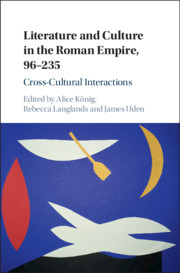Book contents
- Literature and Culture in the Roman Empire, 96–235
- Literature and Culture in the Roman Empire, 96–235
- Copyright page
- Contents
- Figures
- Contributors
- Preface
- Timeline
- Abbreviations
- Map
- Introduction
- Part I Refiguring Roman and Greek Interactions
- Part II Imperial Infrastructure: Documents and Monuments
- Part III Cultural Translation and Transformation
- Chapter 13 Bardaisan’s Disciples and Ethnographic Knowledge in the Roman Empire
- Chapter 14 Chaldean Interactions
- Chapter 15 Gilgamos in Rome
- Afterword
- References
- Index
Chapter 15 - Gilgamos in Rome
Aelian NA 12.21
from Part III - Cultural Translation and Transformation
Published online by Cambridge University Press: 28 April 2020
- Literature and Culture in the Roman Empire, 96–235
- Literature and Culture in the Roman Empire, 96–235
- Copyright page
- Contents
- Figures
- Contributors
- Preface
- Timeline
- Abbreviations
- Map
- Introduction
- Part I Refiguring Roman and Greek Interactions
- Part II Imperial Infrastructure: Documents and Monuments
- Part III Cultural Translation and Transformation
- Chapter 13 Bardaisan’s Disciples and Ethnographic Knowledge in the Roman Empire
- Chapter 14 Chaldean Interactions
- Chapter 15 Gilgamos in Rome
- Afterword
- References
- Index
Summary
This chapter explores the dynamics of ancient cross-cultural interactions via a case study from the Severan period. Aelian’s brief narrative of the Mesopotamian hero Gilgamos is a story that connects four cultural traditions: Chaldean, Persian, Greek, and Roman. Included in Book 12 of the De natura animalium, the story tells how the Babylonian king’s fear of being usurped led him to imprison his daughter, who secretly gave birth to a son, Gilgamos, by a man of no distinction. Palace guards threw the baby from the acropolis of Babylon, whereupon the infant Gilgamos was rescued by an eagle. Ostensibly the story celebrates the eagle’s capacity for philanthropia, or devotion to humans, but Aelian is up to much more, as the Gilgamos tale opens up questions of cultural legitimacy, the need for evidentiary proof of belonging, and even the role of writing in the complex processes of cultural transformation. Aelian ultimately rejects legitimacy conferred by nature and opts instead for the adoption even of what is illegitimate, untrue, or unverifiable if it represents a valuable medium of cultural interconnectivity.
- Type
- Chapter
- Information
- Literature and Culture in the Roman Empire, 96–235Cross-Cultural Interactions, pp. 328 - 343Publisher: Cambridge University PressPrint publication year: 2020

